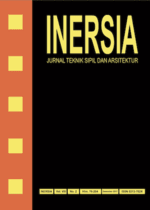An Exploration of Cyclists' Preferences that Influence Route Choice to Recreation in Yogyakarta during COVID-19
DOI:
https://doi.org/10.21831/inersia.v19i2.64870Keywords:
Cyclists, Recreation, COVID 19, Route Choice FactorsAbstract
People's travel behavior has changed significantly as a result of the COVID-19 pandemic. The growing number of cyclists, particularly those who ride for recreation, and how they view the options for recreational riding routes are two of the elements that are being impacted. Cycling route preferences may be viewed differently than they were prior to the pandemic. It will be crucial to understand cyclists' behavior while choosing their routes in order to choose the development, especially for cycling infrastructure. This research aims to explain the perceptions of recreational cyclists regarding the influential factors in determining their routes. The data for this study was collected from 340 respondents who use bicycles for recreation in Yogyakarta City. A questionnaire was used to collect data by examining the factors that influence cyclists in determining their routes, such as infrastructure conditions, traffic conditions, environmental conditions, and travel plans, using a Likert scale. Through the questionnaire, socio-demographic characteristics of the respondents were obtained, revealing that the majority were male, with incomes below Rp 1,500,000, and aged below 25 years. The analysis methods used in this study were descriptive analysis, importance score analysis, and chi-square tests between the characteristics of the cyclists and each factor. The results showed that the most important factors for recreational cyclists in determining their routes in Yogyakarta City are the availability of street lighting facilities (4.34), good road conditions (4.31), the presence of dedicated bicycle lanes (4.30), low traffic volume (4.30), and the natural environment (4.29). Additionally, the frequency of recreational cycling statistically correlates significantly with some factors, such as the availability of bicycle lanes, bike boxes, and low pollution levels.
References
A. Nikitas, S. Tsigdinos, C. Karolemeas, E. Kourmpa, and E. Bakogiannis, "Cycling in the Era of COVID-19: Lessons Learnt and Best Practice Policy Recommendations for a More Bike-Centric Future," Sustainability, vol. 13, no. 9, p. 4620, Apr. 2021, doi: 10.3390/su13094620.
A. Francke, "Cycling during and after the COVID-19 pandemic," in Advances in Transport Policy and Planning, vol. 10, Elsevier, 2022, pp. 265–290.
PeopleForBikes Staff, "How Bicycling Changed During A Pandemic." [Online]. Available: https://www.peopleforbikes.org/news/how-bicycling-changed-during-a-pandemic
Streetlight Data, "COVID Transportation Trends: What You Need to Know About the "˜New Normal.'" [Online]. Available: https://learn.streetlightdata.com/covid-transportation-trends
Eco Counter, "Bike count dashboard: tracking the growth of cycling by country." [Online]. Available: https://www.eco-counter.com/cycling-data-tracker/
P. Rérat, L. Haldimann, and H. Widmer, "Cycling in the era of Covid-19: The effects of the pandemic and pop-up cycle lanes on cycling practices," Transp. Res. Interdiscip. Perspect., vol. 15, p. 100677, 2022.
D. R. Budi et al., "Cycling during covid-19 pandemic: Sports or lifestyle," Int. J. Hum. Mov. Sports Sci., vol. 9, no. 4, pp. 765–771, 2021.
ITDP, "During Coronavirus, Jakarta's Cycling Grows as does Police Backlash." [Online]. Available: https://www.itdp.org/2020/07/10/during-coronavirus-cycling-grows-as-does-police-backlash/
S. Kraus and N. Koch, "Provisional COVID-19 infrastructure induces large, rapid increases in cycling," Proc. Natl. Acad. Sci., vol. 118, no. 15, p. e2024399118, 2021.
R. Buehler and J. Pucher, "COVID-19 impacts on cycling, 2019–2020," Transp. Rev., vol. 41, no. 4, pp. 393–400, 2021.
City Government of Yogyakarta, "Pemkot Yogya Kembangkan Jalur Sepeda Wisata "˜Monalisa.'" [Online]. Available: https://warta.jogjakota.go.id/detail/index/14665
M. H. Nguyen and D. Pojani, "The emergence of recreational cycling in Hanoi during the Covid-19 pandemic," J. Transp. Health, vol. 24, p. 101332, 2022.
M. Abdullah, N. Ali, S. A. Hussain, A. B. Aslam, and M. A. Javid, "Measuring changes in travel behavior pattern due to COVID-19 in a developing country: A case study of Pakistan," Transp. Policy, vol. 108, pp. 21–33, Jul. 2021, doi: 10.1016/j.tranpol.2021.04.023.
S. Das, A. Boruah, A. Banerjee, R. Raoniar, S. Nama, and A. K. Maurya, "Impact of COVID-19: A radical modal shift from public to private transport mode," Transp. Policy, vol. 109, pp. 1–11, Aug. 2021, doi: 10.1016/j.tranpol.2021.05.005.
A.-M. Schweizer, A. Leiderer, V. Mitterwallner, A. Walentowitz, G. H. Mathes, and M. J. Steinbauer, "Outdoor cycling activity affected by COVID-19 related epidemic-control-decisions," Plos One, vol. 16, no. 5, p. e0249268, 2021.
T. Shibayama, F. Sandholzer, B. Laa, and T. Brezina, "Impact of COVID-19 lockdown on commuting: A multi-country perspective," Eur. J. Transp. Infrastruct. Res., vol. 21, no. 1, pp. 70–93, 2021.
M. Z. Irawan, I. G. A. Andani, A. Hasanah, and F. F. Bastarianto, "Do cycling facilities matter during the COVID-19 outbreak? A stated preference survey of willingness to adopt bicycles in an Indonesian context," Asian Transp. Stud., vol. 9, p. 100100, Jan. 2023, doi: 10.1016/j.eastsj.2023.100100.
R. N. Ramirez Juarez, A. B. Grigolon, and A. M. Madureira, "Cyclists' perception of streetscape and its influence on route choice: A pilot study with a mixed-methods approach," Transp. Res. Part F Traffic Psychol. Behav., vol. 99, pp. 374–388, Nov. 2023, doi: 10.1016/j.trf.2023.10.029.
R. Song, Y. Ni, and K. Li, "Understanding cyclists' risky route choice behavior on urban road sections," Transp. Res. Procedia, vol. 25, pp. 4157–4170, 2017.
S. Bernardi, L. La Paix Puello, and K. Geurs, "Modelling route choice of Dutch cyclists using smartphone data," J. Transp. Land Use, vol. 11, no. 1, pp. 883–900, 2018.
A. B. P. Segadilha and S. da Penha Sanches, "Identification of factors that influence cyclistÅ› route choice," Procedia-Soc. Behav. Sci., vol. 160, pp. 372–380, 2014.
W. H. Greene, D. A. Hensher, and J. M. Rose, Applied Choice Analysis: A Primer. Cambridge: Cambridge University Press, 2005. doi: 10.1017/CBO9780511610356.
P. H. L. Bovy and M. Bradley, "ROUTE CHOICE ANALYZED WITH STATED-PREFERENCE APPROACHES," Transp. Res. Rec., 1985, [Online]. Available: https://api.semanticscholar.org/CorpusID:107710478
G. Menghini, N. Carrasco, N. Schí¼ssler, and K. W. Axhausen, "Route choice of cyclists in Zurich," Transp. Res. Part Policy Pract., vol. 44, no. 9, pp. 754–765, 2010.
T. A. Petritsch, B. W. Landis, H. F. Huang, and S. Challa, "Sidepath safety model: bicycle sidepath design factors affecting crash rates," Transp. Res. Rec., vol. 1982, no. 1, pp. 194–201, 2006.
T. Hyodo, N. Suzuki, and K. Takahashi, "Modeling of bicycle route and destination choice behavior for bicycle road network plan," Transp. Res. Rec., vol. 1705, no. 1, pp. 70–76, 2000.
M. A. Stinson and C. R. Bhat, "Frequency of bicycle commuting: internet-based survey analysis," Transp. Res. Rec., vol. 1878, no. 1, pp. 122–130, 2004.
R. B. Noland and H. Kunreuther, "Short-run and long-run policies for increasing bicycle transportation for daily commuter trips," Transp. Policy, vol. 2, no. 1, pp. 67–79, 1995.
G. Rondinella, A. Fernandez-Heredia, and A. Monzón, "Analysis of perceptions of utilitarian cycling by level of user experience," 2012.
J. Broach, J. Dill, and J. Gliebe, "Where do cyclists ride? A route choice model developed with revealed preference GPS data," Transp. Res. Part Policy Pract., vol. 46, no. 10, pp. 1730–1740, 2012.
J. Garrard, G. Rose, and S. K. Lo, "Promoting transportation cycling for women: the role of bicycle infrastructure," Prev. Med., vol. 46, no. 1, pp. 55–59, 2008.
M. Winters, K. Teschke, M. Grant, E. M. Setton, and M. Brauer, "How far out of the way will we travel? Built environment influences on route selection for bicycle and car travel," Transp. Res. Rec., vol. 2190, no. 1, pp. 1–10, 2010.
J. D. Hunt and J. E. Abraham, "Influences on bicycle use," Transportation, vol. 34, pp. 453–470, 2007.
I. C. N. de Sousa and S. da Penha Sanches, "Comparative analysis of factors affecting the cyclists route choice".
I. N. Sener, N. Eluru, and C. R. Bhat, "An analysis of bicycle route choice preferences in Texas, US," Transportation, vol. 36, pp. 511–539, 2009.
L. Ma and J. Dill, "Associations between the objective and perceived built environment and bicycling for transportation," J. Transp. Health, vol. 2, no. 2, pp. 248–255, Jun. 2015, doi: 10.1016/j.jth.2015.03.002.
B. W. Ritchie, "Bicycle tourism in the South Island of New Zealand: Planning and management issues," Tour. Manag., vol. 19, no. 6, pp. 567–582, 1998.
P. S. Simonsen, B. Jí¸rgensen, and D. Robbins, Cycling tourism, vol. 13. Unit of Tourism Research at Research Centre of Bornholm Bornholm, Denmark, 1998.
C.-F. Chen and P.-C. Chen, "Estimating recreational cyclists' preferences for bicycle routes – Evidence from Taiwan," Transp. Policy, vol. 26, pp. 23–30, Mar. 2013, doi: 10.1016/j.tranpol.2012.01.001.
P. Chen, Q. Shen, and S. Childress, "A GPS data-based analysis of built environment influences on bicyclist route preferences," Int. J. Sustain. Transp., vol. 12, no. 3, pp. 218–231, Jan. 2018, doi: 10.1080/15568318.2017.1349222.
P. Zhao, "The impact of the built environment on bicycle commuting: Evidence from Beijing," Urban Stud., vol. 51, no. 5, pp. 1019–1037, 2014.
K. C. Heesch, B. Giles-Corti, and G. Turrell, "Cycling for transport and recreation: Associations with socio-economic position, environmental perceptions, and psychological disposition," Prev. Med., vol. 63, pp. 29–35, Jun. 2014, doi: 10.1016/j.ypmed.2014.03.003.
J. Heller, I. Kinkorova, P. Vodicka, and T. Mika, "Physiological Profiles of Recreational Runners and Cyclists Aged 20 to 60 Years," Appl. Sci., vol. 12, no. 7, p. 3252, 2022.
F. Rupi, M. Freo, C. Poliziani, M. N. Postorino, and J. Schweizer, "Analysis of gender-specific bicycle route choices using revealed preference surveys based on GPS traces," Transp. Policy, vol. 133, pp. 1–14, 2023.
G. Prati, F. Fraboni, M. De Angelis, L. Pietrantoni, D. Johnson, and J. Shires, "Gender differences in cycling patterns and attitudes towards cycling in a sample of European regular cyclists," J. Transp. Geogr., vol. 78, pp. 1–7, 2019.
A. Battiston et al., "Revealing the determinants of gender inequality in urban cycling with large-scale data," EPJ Data Sci., vol. 12, no. 1, p. 9, 2023.
A. Roslan et al., "Malaysian Cyclist: How visible they are," J. Adv. Veh. Syst., vol. 13, no. 1, pp. 1–7, 2022.
J. Larsen and A. El-Geneidy, "A travel behavior analysis of urban cycling facilities in Montréal, Canada," Transp. Res. Part Transp. Environ., vol. 16, no. 2, pp. 172–177, 2011.
J. Hood, E. Sall, and B. Charlton, "A GPS-based bicycle route choice model for San Francisco, California," Transp. Lett., vol. 3, no. 1, pp. 63–75, 2011.
L. Aultman-Hall, F. L. Hall, and B. B. Baetz, "Analysis of bicycle commuter routes using geographic information systems: implications for bicycle planning," Transp. Res. Rec., vol. 1578, no. 1, pp. 102–110, 1997.
O. Lock, "Cycling Behaviour Changes as a Result of COVID-19: A Survey of Users in Sydney, Australia.," Findings, 2020.
J. Fajans and M. Curry, "Why bicyclists hate stop signs," Access Mag., vol. 1, no. 18, pp. 28–31, 2001.
S. Gí¶ssling and S. McRae, "Subjectively safe cycling infrastructure: New insights for urban designs," J. Transp. Geogr., vol. 101, p. 103340, 2022.
J. Loskorn, A. F. Mills, J. F. Brady, J. C. Duthie, and R. B. Machemehl, "Effects of bicycle boxes on bicyclist and motorist behavior at intersections in Austin, Texas," J. Transp. Eng., vol. 139, no. 10, pp. 1039–1046, 2013.
R. Buehler and J. Dill, "Bikeway networks: A review of effects on cycling," Transp. Rev., vol. 36, no. 1, pp. 9–27, 2016.
Z. D. W. Putra, "Biking and Walking with COVID-19: The Comparison of Active Outdoor Activities Before and During The Pandemic in Yogyakarta," Ecocity World Summit 2021-22 Hosting Partn., p. 181, 2022.
Downloads
Published
How to Cite
Issue
Section
License
Authors who publish with INERSIA journal agree to the following terms:
- Authors retain copyright and grant the INERSIA journal right of first publication with the work simultaneously licensed under Creative Commons Attribution License (CC BY 4.0) that allows others to share the work with an acknowledgment of the work's authorship and initial publication in this journal.
- Authors can enter into separate, additional contractual arrangements for the non-exclusive distribution of the published version of the work (e.g., post it to an institutional repository or edit it in a book), with an acknowledgment of its initial publication in this journal.
- Authors are permitted and encouraged to post their work online (e.g., in institutional repositories or on their website) before and during the submission process, as it can lead to productive exchanges, as well as earlier and greater citation of published work.

INERSIA by https://journal.uny.ac.id/index.php/inersia was distributed under a Creative Commons Attribution 4.0 International License







